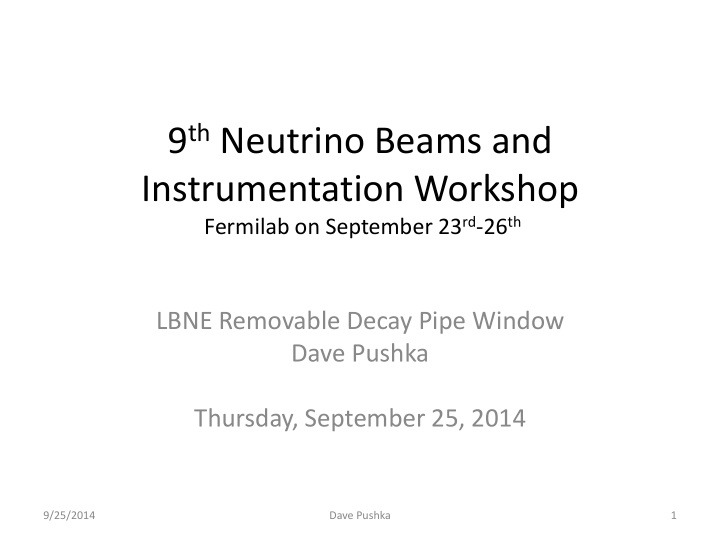



9 th Neutrino Beams and Instrumentation Workshop Fermilab on September 23 rd -26 th LBNE Removable Decay Pipe Window Dave Pushka Thursday, September 25, 2014 9/25/2014 Dave Pushka 1
TOPICS: • Energy Deposition, Temperature, Stresses and Strains • Seal Technology Investigations • Remote Seal Clamping Alternatives • Additional Considerations 9/25/2014 Dave Pushka 2
ENERGY DEPOSITION, TEMPERATURE, STRESSES AND STRAINS • Energy Deposition calculated using MARS by Dianne Reitzner • Energy deposition used to calculated an internal energy generation term used in ANSYS • ANSYS used by Ang Lee to calculate temperatures, resulting thermal stresses. • Considering normal beam condition & accident conditions at 120, 80 and 60 GeV : 9/25/2014 Dave Pushka 3
ENERGY DEPOSITION, TEMPERATURE, STRESSES AND STRAINS • Multiple cases considered: • 120 GeV beam with 1.2 and 2.4 MW • 80 GeV beam with 1.07 and 2.14 MW • 60 GeV beam with 1.03 and 2.06 MW • All cases run for: • Beam hitting target, centered on window • Beam missing target, centered on target (an accident condition) • Beam missing target, hitting window off centered (an accident condition) 9/25/2014 Dave Pushka 4
INTERNAL ENERGY GENERATION FOR ONE CASE (DIANNE AND ANG’S WORK): 9/25/2014 Dave Pushka 5
BOUNDARY CONDITIONS Air Side, convection with h = 7 W/m^2-K, Air temperature at 30 C Helium Side, convection with h = 9 W/m^2-K, Helium temperature at 52 C 9/25/2014 Dave Pushka 6
PURPOSE OF FEA WORK: Evaluate window lifetime as a function of: • Beam spot size • Convection boundary conditions • Chilled fluid at window perimeter boundary condition 9/25/2014 Dave Pushka 7
Ang Lee’s Temperature Result (@120 Gev) by increasing the convection film coefficient, h c : hc_air side The center of the window_ Be alloy flange (W/m^2*K ) section Tave(Steady Tmax_C Tmin_C ∆T _C Tmax_C ∆T _C state)_C 120 Gev 2.4 MW 7 85 87.75 84.25 3.5 115 0 120Gev 2.4 MW 14 68 70.69 67.27 3.42 86.8 0 80 Gev_ 7 79 80.6 78.73 1.87 105 0 2.14 MW 80 Gev 2.14 MW 14 64.05 65.4 63.53 1.87 80.4 0 Note: a) Increase the convective hc_air side from 7 to 14 W/m^2*K, the temperature goes down ~15 C in the center and ~25C at the flange. The ∆T is about the same. The similarity is observed for 120 GeV case 9/25/2014 Dave Pushka 8
SEAL PERFORMANCE REQUIREMENTS: 0.3 bar (5 psig) helium Permissible leakage rate: 0.01 liters per minute (200 cubic feet per year) (this leakage rate specification is pretty arbitrary) Significant Prompt radiation exposure Significant post-running activation 9/25/2014 Dave Pushka 9
Seal Investigations: Eliminated from Further To be further investigated: Consideration: • Commercial Products: • Elastomer O-rings – Helicoflex (spring energized • Lead Gasket alumium “C” Seal) • Indium wire – Parker ESI (spring energized • Mercury Amalgam alumium “C” Seal) • Cast Materials • Peanut Seal as used on the • Conflat gaskets 15’ bubble chamber (an inflatable metal seal). 9/25/2014 Dave Pushka 10
HELICOFLEX SEAL ORDERED FOR TESTING: 9/25/2014 Dave Pushka 11
Seal Leakage Test Vessel Can test ~ 1 meter diameter seals. Externally applied sealing force (hydraulically actuated with load cells) Internally pressurized with helium (or other inert gas) to 5 psig Measure leak rate down to 0.02 scfh (200 cu ft/year or 10 cc/min) 9/25/2014 Dave Pushka 12
PEANUT SEAL: 9/25/2014 Dave Pushka 13
COMMERCIALLY AVAILABLE SEALS: EnPro Industries (the manufacture of Helicoflex) also offers a similar set of metal seals. 9/25/2014 Dave Pushka 14
CLOSURE MECHANISMS: Wedge system Initial design conceived by Kris Anderson and Glenn Waver. Autoclave Closure Flange Standard industry detail used for ‘quick - opening’ vessel ends. 4 – bar (parallelogram) linkage Commonly used mechanism for applying high seal loads to large vacuum gate valves All seal loading mechanism will be driven from the top through about 2 meters of shielding material 9/25/2014 Dave Pushka 15
9/25/2014 Dave Pushka 16
ADDITIONAL CONSIDERATIONS: Helium Vessel will be slightly pressurized above atmospheric pressure . Do we allow the helium to escape? A loss of 2500 cu meters of helium gas Do we recover the helium, fill the decay pipe with CO2, then change the window? Takes time to setup, perform, and re-fill the decay pipe Do we include a temporary helium seal to isolate the decay pipe from the window change mechanism? Significant design time, perhaps additional time for a window change Include forced convection on helium side of window as part of the module? 9/25/2014 Dave Pushka 17
Recommend
More recommend